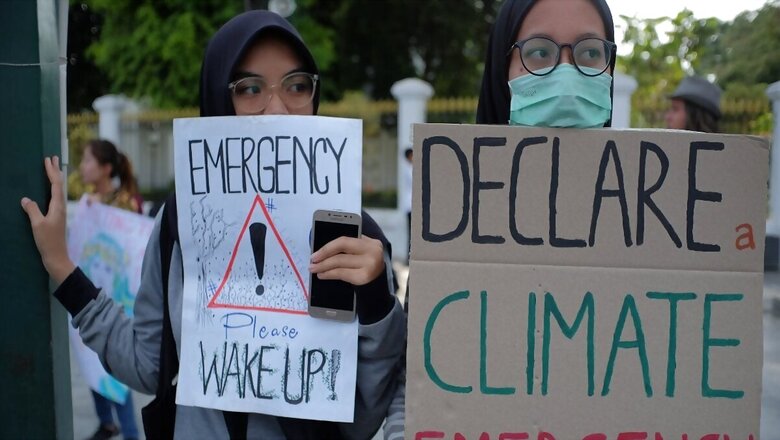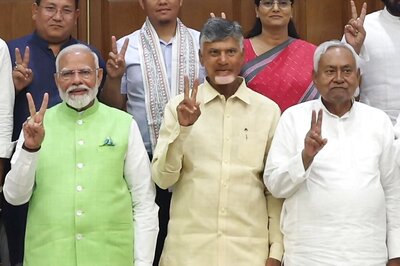
views
Everything, everywhere and all systems together. The Intergovernmental Panel on Climate Change (IPCC) Synthesis report, released in March 2023, summarising its five years of work on climate impacts, tells us that transformational change is the only way to tackle an accelerating global climate crisis in the Anthropocene. Fragmented and siloed responses to this systemic crisis are doomed to fail, as they have over the last 30 years. Since the 1990s, global warming has risen from 0.5oC to 1.1oC, as countries and firms have bickered about whether climate change was happening or not, or whether development was more important than climate action.
Climate change poses a clear and present danger to human well-being and our ecosystem across the world, especially in large countries like India with hundreds of millions of poor and vulnerable people. The evidence is crystal clear. Climate impacts and risks will worsen dramatically with every small increase in warming. We also know that climate risks affect regions and people unequally. Nearly 3.6 billion people in Asia, Africa, Central and South America, and small islands are highly vulnerable to climate change and will face disproportionate climate risks and disasters. These people, who have also historically contributed the least to climate change, will suffer the most losses and damages.
A sustainable, equitable and just future for all of us rests on making fundamental changes in how we live, work, produce and consume and how we conserve and protect our ecosystems.
CRD brings climate and development goals together
This calls for a new development paradigm that moves away from tired 20th-century dichotomies of the economy vs the environment, sustainability vs growth, and equity vs justice. The IPCC presents Climate Resilient Development (CRD) as a new development model for the Anthropocene. Anchored in principles of equity, justice and inclusion, CRD brings climate and development goals under one umbrella. It does this by integrating climate adaptation (to reduce risks), climate mitigation (to reduce emissions), biodiversity conservation and sustainable development, for which all countries agreed on a set of common goals for 2030.
Social safety nets for the poor; universal environmental services like clean water supply, sanitation, and storm drainage; upgradation of informal settlements with climate resilient infrastructure; promotion of low carbon public transport are all examples of CRD implementation in urban areas. It is enabled when all stakeholders, including governments at all levels, firms and civil society come together to make choices that expand the development co-benefits of climate actions. For example, by creating livelihood opportunities in new industries.
Transition to CRD however requires robust financing and redirecting investment away from fossil fuel discovery and subsidies that lock millions of people into energy poverty, when cost-effective renewable energy systems are being successfully deployed across the world. We can transition to a climate-resilient future when dramatically expanded public, private, domestic and international finance are aligned via appropriate regulatory frameworks and incentives.
To put things in context, global climate finance in 2019-20 was only a third of the investment required to maintain us on a pathway well below 2°C. In the face of more intense and frequent climate impacts, the finance for adaptation is abysmally low at around 7 percent of the total climate finance in 2019-20. The IPCC tells us both public and private finance investments in fossil fuels continue to be greater than that for climate mitigation or adaptation. Not surprisingly, the biggest shortfall in climate finance is for developing countries that need it the most.
Mobilising climate finance flows to developing countries
One of the challenges of global climate finance is that it needs to address three simultaneous goals. First, bridging the current infrastructure investment deficit in the developing world and replacing aging assets in the developed world. Second, to redirect these investments and subsidies away from fossil fuel infrastructure e.g. coal-fired power plants and oil and gas discovery, towards low carbon investments. Third, ensuring that enough resources are available for low-carbon infrastructure and adaptation, in developing countries.
The global infrastructure investment gap is very large at between $15-30 trillion. The global low-carbon investment can be met by redirecting about 2.4 percent of global savings, according to a 2020 Green Climate Fund report. But, the political and investor appetite, even for this, is not yet visible.
There are deep structural barriers to the flow of climate finance to developing countries. Nearly three-quarters of global climate finance still stay in high-income countries, to avoid the perceived political, regulatory and economic risks of investments in developing countries. Even the $100 billion a year in climate finance pledged in 2009, by rich countries to developing countries, is yet to arrive.
Turn-around in global to local climate finance requires the international community including multilateral financial institutions, governments, central banks and private finance to come together to reduce investment risks in developing countries. Both market shaping and market fixing measures will be needed to deliver climate finance where it is most needed.
A modest start can be made with the rich nations delivering their commitment of $100 billion of public financial assistance a year. Other measures include greater use of government guarantees and multi-country guarantee funds to lower the costs of private finance; reducing the increasing debt burden of many developing countries through debt-for-climate swaps; developing local capital markets; more transparent climate disclosure norms; and improving developing countries’ access to green bonds and ESG financing.
Climate resilient development gives us a clear set of options to choose from to scale up the joint implementation of sustainable development and effective mitigation and adaptation. We need to commit to serious governance and financial reforms to accelerate this transition to ensure a secure and better tomorrow for all.
The author is director of Indian Institute for Human Settlements and an IPCC lead co-ordinating author. Views expressed are personal.




















Comments
0 comment